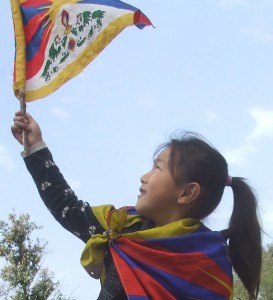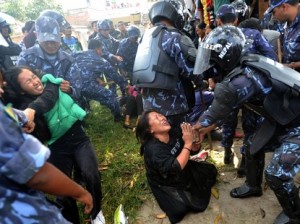On March 10, thousands around the globe crowded streets with Tibetan flags and bold signs to show solidarity for the Tibetan independence movement, which has intensified this year in the wake of, at the time, 107 Tibetan self-immolations. Speakers at the National Uprising Day protests mourned and prayed for the martyrs, but reassured their communities of the struggle’s gained momentum. A wave of international support from the world’s governments surged for Tibet in the week following.
One Tibetan protestor in Dharamsala tried to self-immolate, but was forced to the hospital before he could set himself alight. Inside Tibet, the police presence tripled in efforts to dissuade any March 10th protests, and five Tibetans were arrested in Sichuan for involvement in a demonstration. One monk from the Kirti Monastary in Tsepak was arrested the previous evening for unknown reasons.
A day to stand against oppression
Since 1959’s bloody revolt in Lhasa against the Chinese occupation, National Uprising Day – also recently dubbed “Martyrs’ Day” by the Tibetan Parliament in Exile – is a day for those united for Tibetan freedom or autonomy take to the streets, calling on their governments to hold the People’s Republic of China (PRC) accountable for human rights violations and environmental destruction in Tibet. Supporters wore black to mourn those harmed or lost in the decades-long struggle.
Thousands gather in Dharamsala
In McLeod, the Tsulag Khan, the main temple and residence of His Holiness the Dalai Lama, was decorated with Tibetan flags, and there was a festive atmosphere with people carrying and wearing flags. The rally began with children from TCV in traditional dress leading the crowd singing the National Anthem as the Prime Minister of the Tibetan Governent in Exile, Sikyong Lobsang Sangay, unfurled the Tibetan flag, followed by a minute’s silence for Tibet’s martyrs. After the Prayer for Compassion, Sangay spoke to the crowd about Tibetans’ grievances within Tibet, and the reasons behind their protests and self-immolations. He also addressed the crowd’s spirit of resistance:
“The yearning for freedom that moved our elders… is a beacon that guides our present-day struggle to secure our basic freedom, dignity, and identity,” Sangay said. “The character of our people is being shaped by our endurance of the darkest period of Tibetan history.”
He concluded that his administration will continue to call for international support for Tibetan human rights, and that the Middle Way approach is in the “best interests of both China and Tibet.”
Afterward, protesters carrying flags and chanting slogans marched down to Lower Dharamsala where they gathered for a rally of music, songs, and speakers from the Indian government and leaders from Tibetan NGOs. Students for a Free Tibet addressed the crowd with an activist’s messages of hope and movement.
“There is a new revolution we are seeing inside Tibet,” Tenzin Jigdal said. “Tibetans inside Tibet are in search of Tibetan identity and their aspiration has never been stronger.”
Though SFT is staunchly pro-Indepdence, Jigdal explained to the crowd that ideology is not as important as the current, urgent situation that Tibetans face within Tibet today, and that the top priority must be to relieve their suffering.
The march in Dharamsala was organized by the five main NGO’s of the Tibetan exile community: Tibetan Youth Congress, Students for a Free Tibet, Tibetan Women’s Association, Gu Chu-Sum, and National Democratic Party of Tibet.
A fiery protest prevented
As the presenters broadcast speeches, one man named Dawa swallowed kersone and also poured the liquid on his body.
The surrounding crowd heard some young women pleading “Please don’t do it,” and a number of people intervened as Dawa attempted to self-immolate. Speaking to Phayul, eye witness Sangchu Dugbey reported that “[Dawa] pleaded with us to let him self-immolate… he had decided to set himself on fire after thinking it over many times.” Dawa, in his 30’s, was rushed to Delek Hospital and remains in stable condition.
Stifled Uprising Day inside Tibet
In PRC-controlled Tibet, however, freedom of speech was not an option. Radio Free Asia wrote that Tibetan sources reported a massive security sweep in Lhasa, starting three days before Uprising Day and aimed at cell phones and computers. Following the destruction of satellites in Eastern Tibet last month, the PRC aims to further cut Tibetans off from exchanging news with the exiled community, particularly on Martyrs’ Day.
International Support
In India, not only did many cities stage protests on Martyr’s Day, but a solidarity rally in New Delhi drew over 2000 Tibetan supporters. The rally began with an interfaith prayer and a minute’s silence for fallen Tibetan protestors. Prominent Indian leaders from numerous parties spoke at the rally, and Dr. N.K. Trikha, National Convener of Core Group for Tibetan Cause, expressed concern on behalf on the Indian nation and reaffirmed that the “Indian people” had always, and would continue to, stand by Tibet.
This year saw strong international support, with protests in over 30 countries. Over 5,000 protestors massed in Brussels, Belgium; 3,000 in New York City, USA; 1,200 in Taipei, Taiwan; and many thousands more across the globe.
The Central Tibetan Administration sent Kalons to other exile Tibetan communities, to inform them of the CTA’s policies and efforts on behalf of the violence and oppression in Tibet. Delegations spoke in France, Australia, Belgium, Japan, India (Ladakh), the USA, and Taiwan.
Sources: Phayul, Radio Free Asia, Tibetan Center for Human Rights and Democracy, International Campaign for Tibet







 Print
Print Email
Email